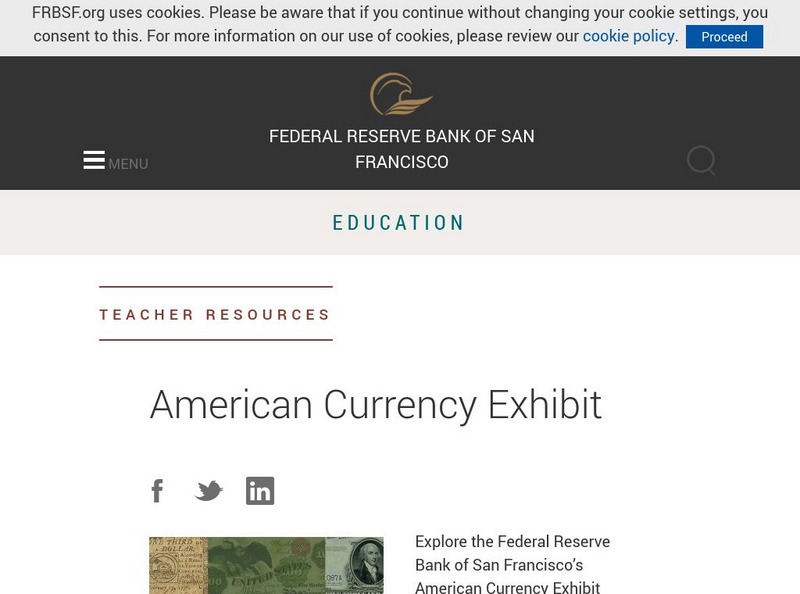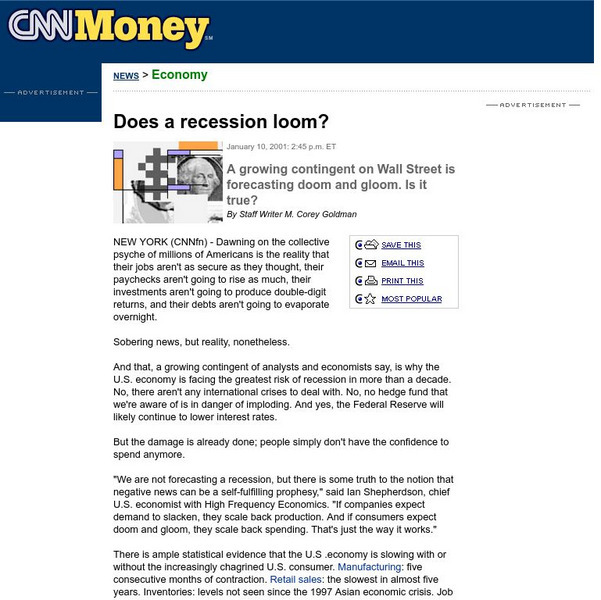Mr. Nussbaum
Money
Young readers test their comprehension skills with an interactive practice. Pupils read a brief informational text about money then answer five questions. A detailed page appears at the end to showcase participants' work.
Federal Reserve Bank
Federal Reserve Bank of Philadelphia: Money in Colonial Times
Comprehensive overview of the development of money in the American colonies. Topics covered include colonial coins and paper money, national coinage, copper, silver, and gold coins, and Liberty and the eagle.
Practical Money Skills
Visa: Practical Money Skills for Life
Visa provides a resource that teachers, parents, and students will all enjoy using. There are lesson plans here for all ages, as well as information about spending decisions, budgeting, and money management. Print your own play money,...
US Mint
U.s. Mint: Presidential $1 Coins
The U.S. Mint site provides some interesting information about the coinage of U.S. Presidents on our currency.
Federal Reserve Bank
Federal Reserve Bank of San Francisco: American Currency Exhibit
The Federal Reserve Bank of San Francisco's American Currency Exhibit includes a Showcase of Bills, a Tour of Exhibits by Era, Historical Context, Artistry and Imagery, and an Index of Bills.
CNN
Cnn Money: Twitter, Pipe Dream or Next Big Thing?
Twitter has taken the world by storm, even made its name a verb, but are they challenged late in the game to try making money from the service? This article examines this question in depth.
Federal Reserve Bank
Federal Reserve Bank of Minneapolis: The History of Money
The Federal Reserve Bank of Minneapolis traces the history of money up from coins in ancient times to modern paper, currency, and e-money.
Smithsonian Institution
Smithsonian Learning Lab: What Shape Is Money? Money Doesn't Have to Be Round or Rectangular
Pigs, rice, nuts, teeth, eggs, feathers - these are all types of currency! This lesson discusses different types of objects that can be used as currency and students will decide what qualities make an effective currency. Included are...
Khan Academy
Khan Academy: Lesson Summary: Definition, Measurement, and Functions of Money
This information is intended for AP Macroeconomics students or for those taking college macroeconomics. This lesson reviews key terms and calculations related to the definition, measurement, and functions of money. Topics include the...
Council for Economic Education
Econ Ed Link: Do I Look Like I'm Made of Money?
One of the most common replies given by parents when their children ask for money is "Do I look like I'm made of Money?" This lesson is designed to educate learners about the need for money as a generally accepted medium of exchange. The...
Better Lesson
Better Lesson: Time and Money
As the result of a Unit assessment, it was found that students showed some confusion with writing time and with adding sets of coins. These skills need to be reviewed to aid in mastery of the Common Core standards for time and money.
Better Lesson
Better Lesson: More Dimes and Dollars
Second graders need practice using coins and dollars and relating them to ones, tens and hundreds. Common Core standards include counting by 10s and 100s.
US Mint
U.s. Mint: Circulating Coins
Read the complete history of current circulating coins. Find out about the symbols, size, and the metal composition of these coins.
Scholastic
Scholastic: Adventures in Math: Lesson 3: Money in Our Community
Lesson focuses on how and why money circulated within our community. Being able to discern the difference between things we need and things we want is one of the foundational concepts for using money wisely. Goods and services are things...
Bibliomania
Bibliomania: The Man Who Kept His Money in a Box
This Bibliomania webpage features the full text of Anthony Trollope's short story "The Man Who Kept His Money in a Box." A link is provided to Bibliomania's Anthony Trollope main page, which has links to other Trollope works.
Texas Education Agency
Texas Gateway: Chapter 13: Introduction to Money and Banking
In this chapter, you will learn about the following: Defining money by its functions; Measuring money-currency; M1, and M2; The role of banks; and How banks create money.
Council for Economic Education
Econ Ed Link: Money Comes and Goes
Students read two online stories that introduce them to the elements of a budget and show that a successful budget balances money coming in (income) with money going out (expenses and savings). Follow-up activities point out the value of...
CNN
Cnn Money: Does a Recession Loom?
What caused the economic recession of 2001? According to this CNN Money article, a lack of consumer confidence to spend money, poor corporate performace, contraction in the manufacturing and retail sales sectors, and job layoffs.
Better Lesson
Better Lesson: Identifying Coins
Find a lesson plan here to help students learn more about money that is all around them! Give them the chance to review coin identification with the coin game and practice.
Better Lesson
Better Lesson: Hundreds, Tens, Ones Are Coins Too
Second graders will extend their understanding of hundreds, tens and ones using dollars, dimes and pennies as another way to express groups of 100, 10 and 1.
Math Aids
Math Aids: Money Worksheets
Great resource to practice and strengthen math skills pertaining to money. Math worksheets are printable, may be customized, and include answer keys.
University of Missouri
University of Missouri: Wise Pockets: Four Dollars and Fifty Cents
This is a lesson plan geared towards elementary level students. Using the book Four Dollars and Fifty Cents by Eric Kimmel, the teacher instructs students about the terms creditor, debtor, collateral, credit, and credit report. Lesson...
Illustrative Mathematics
Illustrative Mathematics: Saving Money 2
The purpose of this task is for students to relate addition and subtraction problems to money and to situations and goals related to saving money. A problem is given that will contain multiple solutions, this allows students to think...
University of Regina (Canada)
University of Regina: Math Central: Time, Money, and Temperature Lesson Plans
Money, time, and temperature are developed through several lessons. These topics of measurement are explained with suggested lessons, evaluations, instructional methods, and resources.















